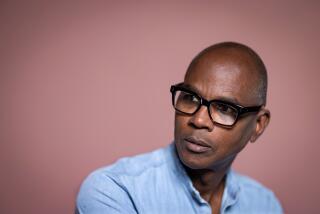The Shape of Dow’s Influence : Painter Who Had Impact on O’Keeffe Is the Subject of Exhibit, Lecture
LAGUNA BEACH — In 1915, when painter Georgia O’Keeffe was a 28-year-old art teacher at a small college in South Carolina, she had a revelation. As she wrote many years later, “I was alone and singularly free, working on my own, unknown, (with) no one to satisfy but myself.”
And it suddenly struck her that “I had things in my head not like what I had been taught, not like what I had seen (but) shapes and ideas so familiar to me that it hadn’t occurred to me to put them down. I decided to stop painting, to put away everything I had done, and start to say the things that were my own.”
As Hunter Drohojowska explained Thursday in a lecture at the Laguna Art Museum, the aesthetic philosophy of Arthur Wesley Dow was a major catalyst for O’Keeffe’s change of mind. An East Coast painter influenced by Japanese art, Dow is the subject of an exhibit at the museum through Sept. 1.
Drohojowska is chair of the department of liberal arts and sciences at Otis/Parsons School of Art and Design in Los Angeles and the author of a forthcoming book on O’Keeffe, to be published by Alfred A. Knopf.
O’Keeffe’s talent in art was first nurtured by the principal of the private girls’ school she attended as a teen-ager. That attention led her to study at the Art Institute of Chicago and the Art Students League in New York, where she was a prize pupil of flamboyant painter William Merritt Chase. Then, a combination of illness and family financial problems made her think about giving up art entirely.
But in 1912 she took a summer school course at the University of Virginia with Alan Bement, who had embraced Dow’s principles. They liberated her, Drohojowska said, “from the slavish pursuit of realism.”
Dow preached the power of line, tone, color and what he called “filling space in a beautiful way.” He was born in 1857 in Massachusetts, studied academic painting in Paris in the mid-1880s and spent his summers in Pont-Aven in Brittany, the famous stomping ground of such Post-Impressionist painters as Paul Gauguin and Emile Bernard. But the buttoned-up young New Englander apparently was not interested in their work.
That attitude was to change when Dow returned to the United States in the early 1890s, when “art for art’s sake” was in vogue in sophisticated circles. He met Ernest Fenollosa, curator of Asian art at the Museum of Fine Arts in Boston, and became interested in the Asian-influenced art of James MacNeil Whistler. Eventually, he began to see how the lyrical grace of Japanese woodblock prints could change the direction of his work.
In his 1899 handbook for art teachers, “Composition,” Dow disapproved of teaching methods that involved copying nature. Instead, he insisted that even beginners could create pleasing landscape and still-life compositions based on the principle of “a few lines harmoniously grouped together.” He discounted the importance of knowing about a subject and its history or worrying about accuracy. “The most important thing,” he said, “is beauty.”
O’Keeffe’s direct contact with Dow came when, after teaching high school art in Amarillo, Tex., and at the University of Virginia, she needed an additional teaching credential. In 1914 she enrolled at Teachers College, Columbia University, where Dow was director of the art department.
Recalling how O’Keeffe’s art and lifestyle (her adobe house in Santa Fe, her all black-and-white clothing, her rock collection) inevitably are intertwined in most accounts, Drohojowska said that Dow “was the first to erase the division (between art and life) for her”--a way of living based on aspects of Japanese culture.
Drohojowska showed the audience a slide typical of O’Keeffe’s pre-1915 work: a soft, rather girlish painting of white flowers. Then she showed radically different works influenced by Dow. These included spare charcoal drawings composed of just a handful of lines, and watercolors that explored spiral shapes. Other watercolors from 1916 abstracted the southwestern landscape into variously bold and ethereal horizontal bands of color.
“Each person has only a few shapes in her head,” O’Keeffe once wrote. But by the time she died at 98 in 1986, her fame rested on multitude of variations she coaxed out of those archetypal shapes. Dow would have been proud.
“Arthur Wesley Dow and His Influence” continues through Sept. 1 at the Laguna Art Museum, 307 Cliff Drive in Laguna Beach. Gallery hours are 11 a.m. to 5 p.m. Tuesdays through Sundays. Admission is $2 general, $1 for seniors and students, free for children under 12. (714) 494-6531.
Nancy E. Green, curator of the exhibit, will lecture on Dow and the color woodcut tradition in America on Thursday at 11 a.m. at the museum. Free with museum admission.
More to Read
The biggest entertainment stories
Get our big stories about Hollywood, film, television, music, arts, culture and more right in your inbox as soon as they publish.
You may occasionally receive promotional content from the Los Angeles Times.










